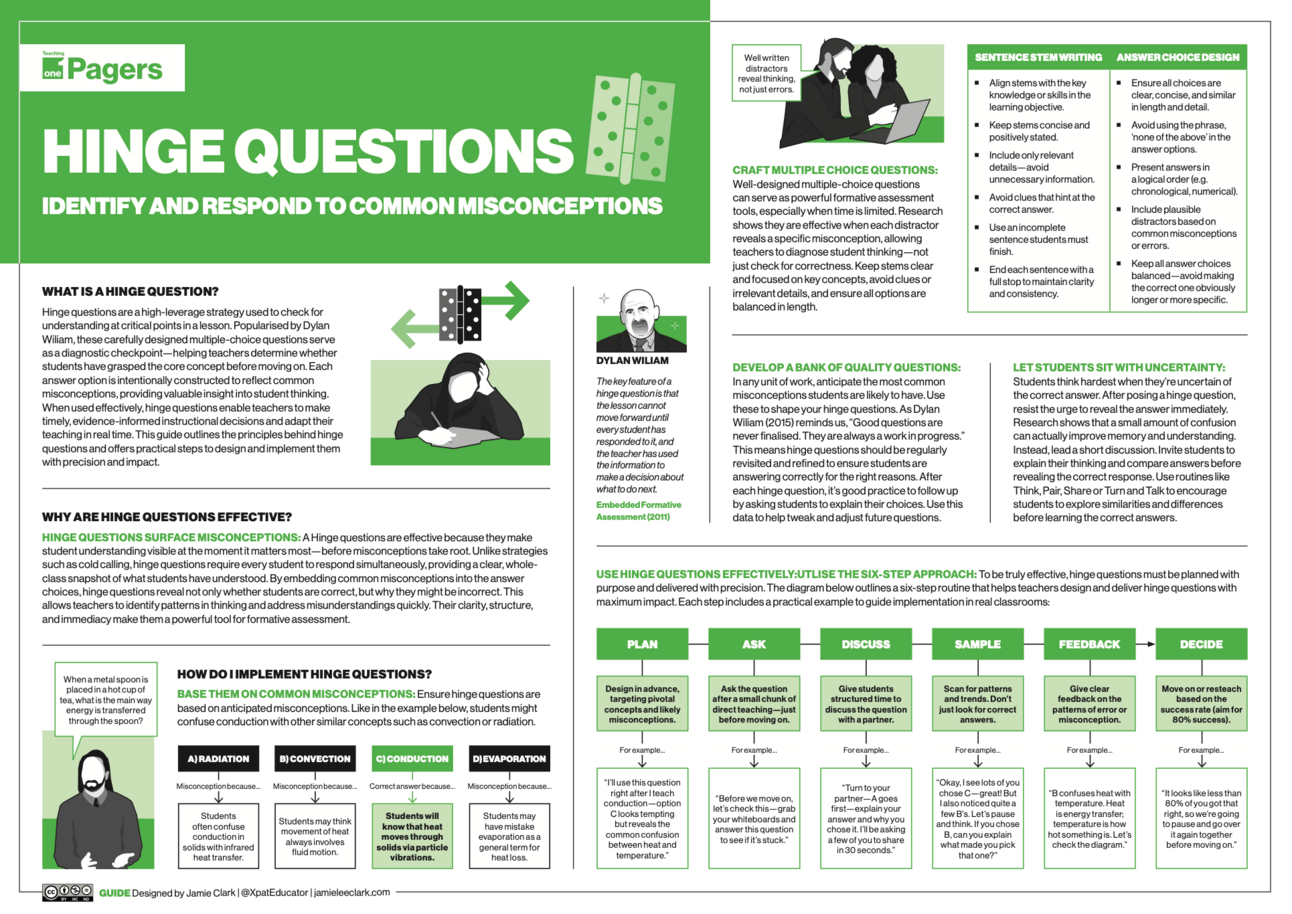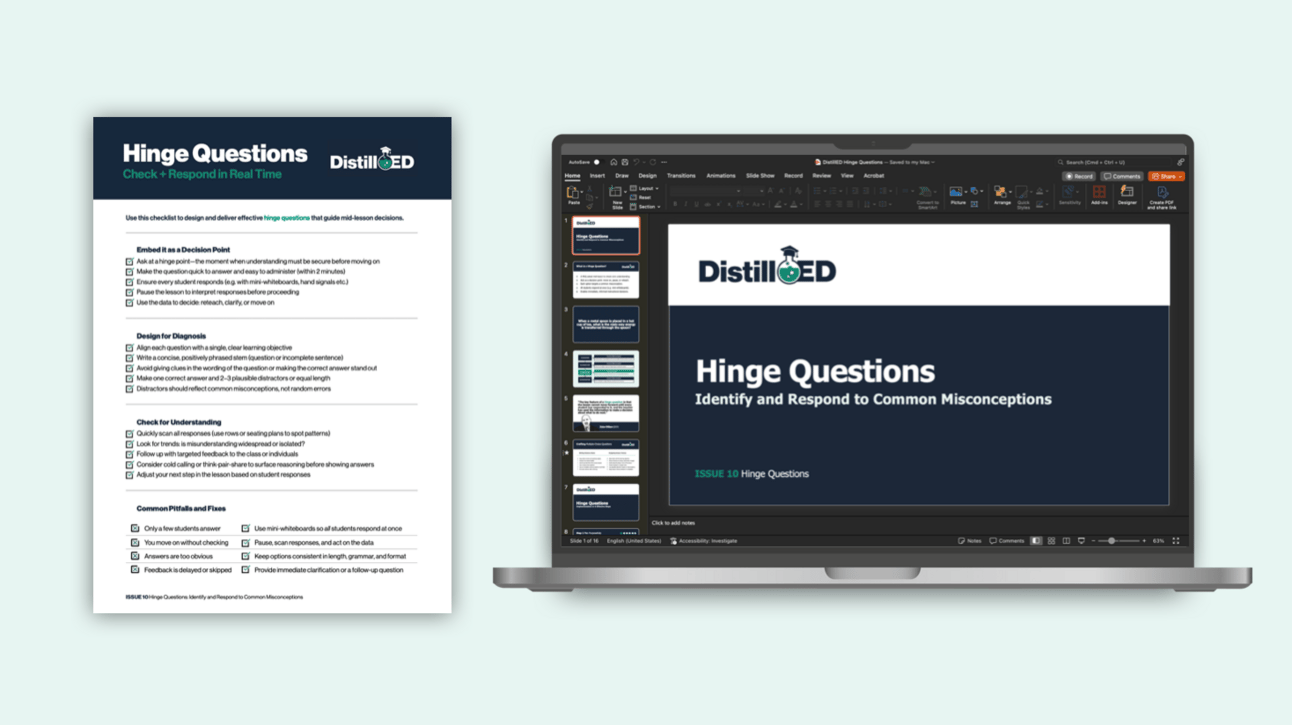👋 G’day {{first name | mate!}}
In this edition of ⚗️DistillED, we explore how to make teaching more responsive and evidence-informed by using hinge questions—a powerful mid-lesson check that helps you uncover misconceptions and guide your next instructional move.

What is a hinge question?
A hinge question is a carefully designed, multiple-choice question used at a key point in a lesson to check whether students understand the core concept being taught.
Popularised by Dylan Wiliam, it acts as a “hinge” in the learning sequence—helping you decide whether to move forward, pause, or reteach based on student responses. It is most effective when each answer option is crafted to reflect a common misconception, giving you insight into student thinking in real time. When paired with tools like mini-whiteboards, hinge questions become a powerful way to catch errors early and steer instruction on the spot.
“The important point is that you do not know what to do until the evidence of students’ achievement is elicited... the lesson hinges on this point.”
Here’s what makes hinge questions so effective:
Checks understanding mid-lesson – allows timely instructional decisions
Targets misconceptions – each option reflects a common misunderstanding
Engages all students – everyone answers at the same time
Reveals patterns in thinking – helps spot trends across the class
Supports responsive teaching – informs whether to reteach or move forward
Promotes deeper discussion – compare, justify, and reflect on choices
This strategy transforms one question into a whole-class formative feedback moment. Here’s what an effective hinge question looks like…

Why are hinge questions effective?
Learning is invisible—we can’t always tell what students know just by looking. That’s why hinge questions are so valuable: they offer a quick real-time insight into what students understand—and what they don’t—at a pivotal moment in the lesson.
“The key feature of a hinge question is that the lesson cannot move forward until every student has responded to it, and the teacher has used the information to make a decision about what to do next.”
So, how do we make sure our hinge questions are written effectively. Let’s look closely at designing clear multiple-choice questions…
How do I implement hinge questions effectively?
Research suggests that MCQs, when carefully designed, can be powerful tools for formative assessment. MCQs are quicker to administer, mark, and analyse—making them ideal for hinge questions used mid-lesson. Here are some tips:
Writing Sentence Stems
Align stems with the key knowledge or skills in the learning objective.
Keep stems concise and positively stated.
Include only relevant details—avoid unnecessary information.
Avoid clues that hint at the correct answer.
Use a simple, direct question.
Use an incomplete sentence students must finish.
End each sentence with a full stop to maintain clarity and consistency.
Designing Answer Choices
Ensure all choices are clear, concise, and similar in length and detail.
Avoid using the phrase, ‘none of the above’.
Present answers in a logical order (e.g. chronological, numerical).
Include plausible distractors based on common misconceptions or errors.
Keep all answer choices balanced—avoid making the correct one obviously longer or more specific.
Dylan Wiliam advises that hinge questions should be quick for students to answer (ideally within two minutes) and for teachers to interpret (within 30 seconds), ensuring timely instructional decisions.
With this in mind, let’s break down this process:
Step | Explanation | Example |
|---|---|---|
1. Plan Purposefully → Purpose: To target key concepts and likely misconceptions. | Design hinge questions in advance, targeting pivotal concepts and likely misconceptions. Ensure answers are plausible and diagnostic. | “I’ll use this question right after I teach conduction—option C looks tempting but reveals the common confusion between heat and temperature.” |
2. Ask at the Right Moment → Purpose: Check understanding before moving on. | Place hinge questions after a small chunk of input—at a pivotal teaching point. | “Before we move on, let’s check this—grab your whiteboards and answer this question to see if it’s stuck.” |
3. Give Paired-Talk Time → Purpose: Promote visible thinking through dialogue. | Give students structured time to discuss the question with a partner. Use labels (A/B) to direct turns. | “Turn to your partner—A goes first—explain your answer and why you chose it. I’ll be asking a few of you to share in 30 seconds.” |
4. Sample Responses Live → Purpose: Identify trends and uncover misconceptions. | Don’t reveal the answer right away. Instead, scan for patterns and trends. Don’t just look for correctness—look for why students chose what they did. | “Okay, I see lots of you chose C—great! But I also noticed quite a few B’s. Let’s pause and think. If you chose B, can you explain what made you pick that one?” |
5. Provide Feedback → Purpose: Correct misunderstandings and reinforce learning. | Address common errors explicitly and clarify the underlying concept. | “B confuses heat with temperature. Heat is energy transfer; temperature is how hot something is. Let’s check the diagram.” |
6. Adapt the Lesson → Purpose: Makes instruction responsive. | Use the results to adjust pacing, reteach, or refine the question for next time. | “Too many students chose A, but I don’t think it reflected a real misconception—next time I’ll tweak that distractor to better expose the misunderstanding.” |
Until next time — stay curious, stay clear!
Jamie
Where can I find out more?
The One-Page Guide
This free A3 guide summarises the hinge question strategy!

Checklist and Slideshow
This week’s ⚗️DistillED+ resources are a checklist and PowerPoint slideshow to use for teacher CPD. They include the WHAT, WHY and HOW of effective hinge question design.
Upgrade to ⚗️DistillED+ download the content.

Join DistillED+
Members gain access to expertly curated digital evidence-informed content
UPGRADEA ⚗️DistillED+ subscription gets you:
- Full access to new premium one-page guides
- Full access to evidence-informed strategy checklists
- Full access to slide templates (PowerPoint and Keynote)


